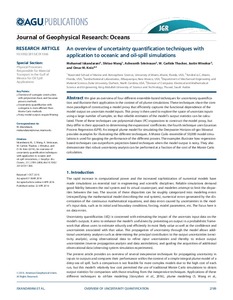An overview of uncertainty quantification techniques with application to oceanic and oil-spill simulations.

View/
Average rating
votes
Date
2016Author
Iskandarani, M.
Wang, S.
Srinivasan, A.
Carlisle Thacker, W.
Winokur, J.
Knio, O. M.
Metadata
Show full item recordAbstract
We give an overview of four different ensemble-based techniques for uncertainty quantification
and illustrate their application in the context of oil plume simulations. These techniques share the common
paradigm of constructing a model proxy that efficiently captures the functional dependence of the
model output on uncertain model inputs. This proxy is then used to explore the space of uncertain inputs
using a large number of samples, so that reliable estimates of the model’s output statistics can be calculated.
Three of these techniques use polynomial chaos (PC) expansions to construct the model proxy, but
they differ in their approach to determining the expansions’ coefficients; the fourth technique uses Gaussian
Process Regression (GPR). An integral plume model for simulating the Deepwater Horizon oil-gas blowout
provides examples for illustrating the different techniques. A Monte Carlo ensemble of 50,000 model simulations
is used for gauging the performance of the differen.....
Journal
Journal of Geophysical Research: OceansVolume
121Page Range
pp.2789-2808Document Language
enSustainable Development Goals (SDG)
14.ABest Practice Type
Manual (incl. handbook, guide, cookbook etc)DOI Original
10.1002/ 2015JC011366Citation
Iskandarani, M.; Wang, S.; Srinivasan, A.; Carlisle Thacker, W. ; Winokur, J. and Knio, O.M. (2016) An overview of uncertainty quantification techniques with application to oceanic and oil-spill simulations, J. Geophyshysical Research: Oceans, 121, pp.2789–2808 DOI:10.1002/2015JC011366.Collections
The following license files are associated with this item:
 Repository of community practices in Ocean Research, Applications and Data/Information Management
Repository of community practices in Ocean Research, Applications and Data/Information Management
